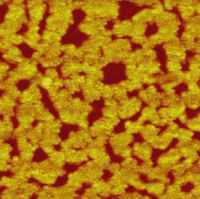
Department of Chemistry, Philipps-University, Hans-Meerwein-St., D-35032 Marburg, Germany
e-mail: schoenaf@staff.uni-marburg.de

 |
Andreas Schönafinger, Norbert Hampp, and Frank Noll
Department of Chemistry, Philipps-University, Hans-Meerwein-St., D-35032 Marburg, Germany e-mail: schoenaf@staff.uni-marburg.de |
 |
MrgA, a DNA-binding protein from bacillus subtilis, forms hexagonally structured protein monolayers on hydrophilic substrates. The lattice formation is strongly dependent on the physicochemical conditions, in particular pH-value, ionic strength and surface charge distribution of the substrates and the protein. Microstructured arrays of semicrystalline MrgA monolayers can be obtained by adsorption of MrgA from aqueous solutions onto structured self-assembled monolayer (SAM) arrays of defined surface properties. These arrays are prepared by microcontact printing and chemisorption of substituted alkanethiols onto ultraflat template-stripped gold (TSG) surfaces. Starting from such MrgA-structures, the bottom-up construction of MrgA-DNA-polylayers of defined height and of a high degree of order are explored and studied by AFM-analysis.